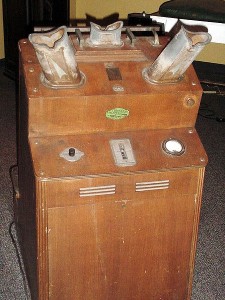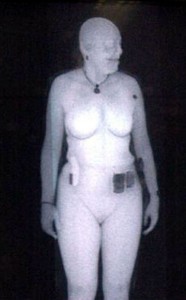The following quote seems a little ironic coming from the genius who produced the first commercially available fluoroscope: “Don’t talk to me about X-rays, I am afraid of them.”- Thomas Edison
It seems as though Edison’s fears were well-founded. Better known as the inventor of the light bulb, phonograph and motion pictures, few people realize that Edison was actually a leading pioneer in the field of x-ray until his assistant, Clarence Dally, died from exposure to fluoroscopes, a device using a type of radiation similar to the scanners in question. That was a hundred years ago, yet somehow we’re slow to take the hint. Proponents are quick to point out that our technology is much better now than it was then, and it is. But that doesn’t justify blindly going along with a potentially dangerous procedure. Before we succumb to a terrorism-induced hysteria, let’s look at our history on the matter.
Unfortunately when x-ray first came on the scene, physicians and other health care workers assumed that what they didn’t see couldn’t hurt them. Then, after years of exposures, leukemia deaths and other radiation related problems started showing up in these people. The dangers of repeated radiation exposure were clearly established and the potentially lethal consequences were broadly understood. Nevertheless, 30 years later Shoe-fitting Fluoroscopes came on the scene in shoe stores as a gimmick to convince parents to buy shoes. It’s really shocking to think that the devices were targeted at children, the group whose growing tissues are most sensitive to radiation. In the photo (below): the child wearing the new shoes would stand at the back where they would insert their feet into the machine; note that there are 3 port holes, one for each parent and one for the child to all look down the business end of the x-ray producing fluoroscope as the child wiggled his or her toes in the would-be new pair of shoes!
It wasn’t until the 1960’s that these horrific devices were completely banned in the U.S. (yet they continued to be used in Europe for another decade). For decades radiologists have been telling women to have mammograms for early detection of breast cancer. The idea was that despite the radiation exposure of the mammogram, earlier detection might save lives. Now that “wisdom” has come under fire as the best science doesn’t support the assumption. A recent study even notes that the procedure may do more harm than good: http://onlinelibrary.wiley.com/o/cochrane/clsysrev/articles/CD001877/frame.html
Yesterday (December 20, 2010) an investigative report was released by AOL News, Andrew Schneider, Senior Public Health Correspondent entitled, “AOL Investigation: No Proof TSA Scanners Are Safe.” The article notes that according to the Transportation Security Administration (TSA) their scans are “…equal to about an hour of normal background radiation, such as the amount absorbed while walking through a park…”
However, the TSA position appears cavalier when we consider, “…most radiation health specialists say there is no “safe” dose of radiation, so any planned exposure must be justified.” http://www.aolnews.com/2010/12/20/aol-investigation-no-proof-tsa-scanners-are-safe/?icid=maing%7Cmain5%7Cdl1%7Csec1_lnk5%7C32490
Scientists universally agree that radiation exposure causes cancer and other serious problems. The only thing that’s in question is just how much is safe. Unfortunately that question has no universal answer, and when big money is involved the science tends to take a back seat to profit.
What’s a rational person to do when the experts disagree? The answer may be simpler than it appears, “Avoid all unnecessary exposures.” I don’t look forward to being groped by a TSA inspector, but if I had to choose between being groped and being radiated – well, radiation damage never goes away.


